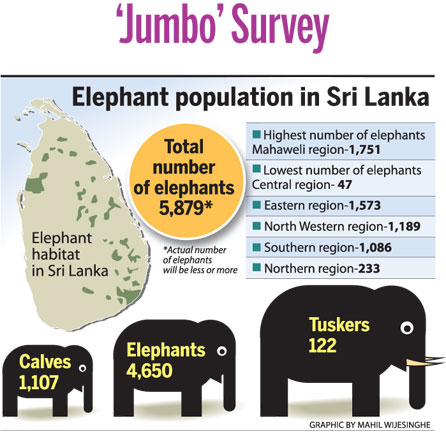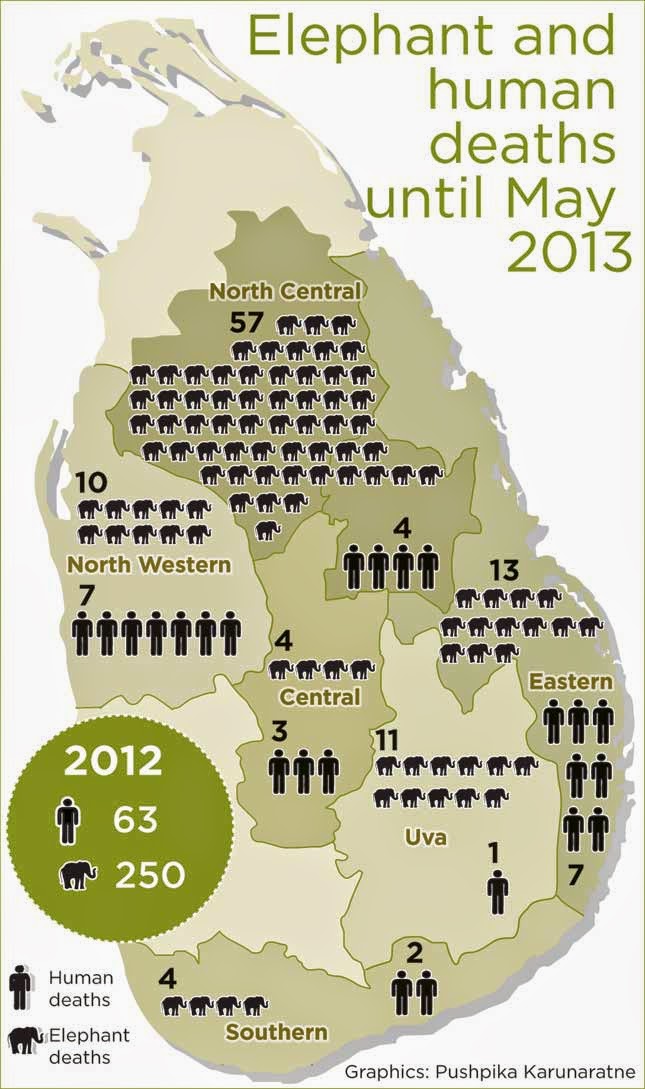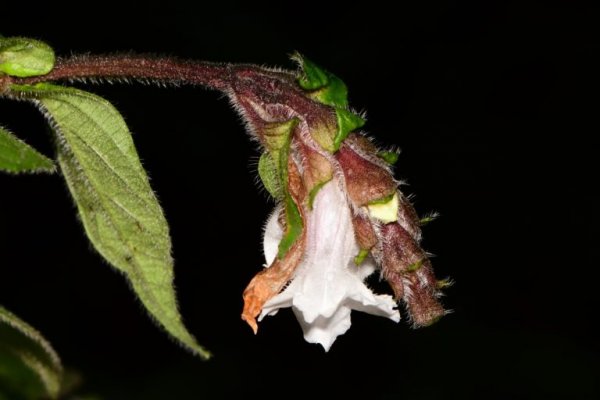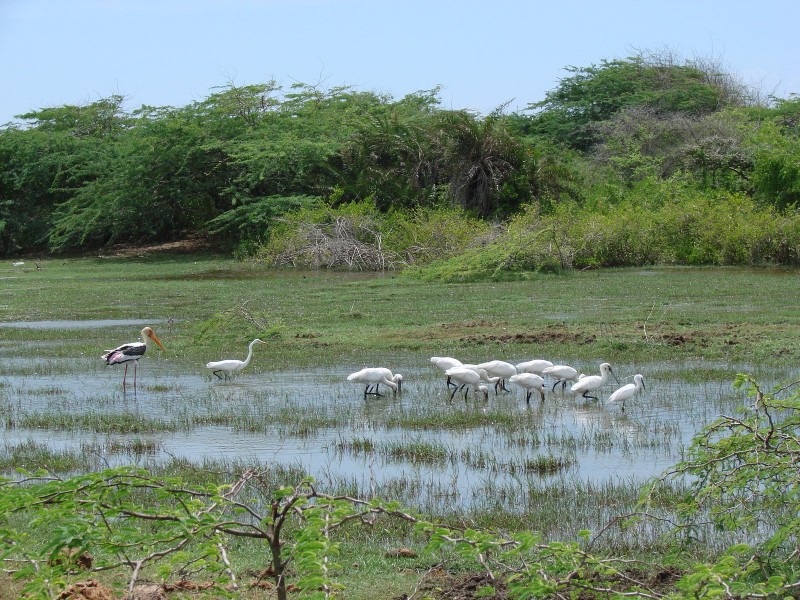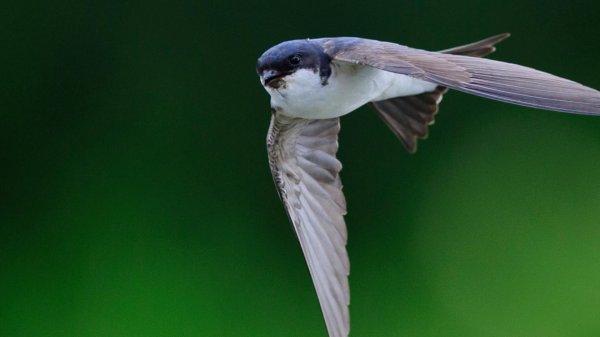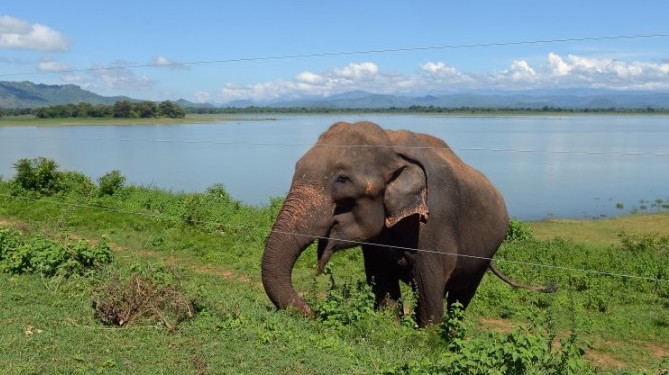
Sri Lanka, given its small size and high human population of 21.3 million, is one of the most densely populated countries in the world. Categorised as a biodiversity hotspot, the island is home to 10% of Asia’s elephant population. However, the elephants are confined to 2% of the country’s land area as stated by the Department of Wildlife Conservation (DWC) and that area too is shrinking at an alarming rate. This loss of habitat is a main reason behind the intensification of the Human-Elephant Conflict.
The recently presented First Island Wide National Survey of Elephants conducted by the DWC recorded 5879 animals on just one day, with 3285 (55.9%) being adults of both sexes, 1487 (25.3%) being sub-adults, 731 (12.4%) being juveniles and the remaining 376 (6.4%) being calves. Of these 5789 wild elephants in Sri Lanka 67.19% live within Protected Area’s of the DWC, 29.78% range among Forest Reserve’s managed by the Forest Department and the remaining 4% or so roam around patches of adjacent forest patches that are located around villages.
However, as development spreads around the country the elephant’s habitat is shrinking. In the Hambantota District alone, during the last few months, 10 elephants and 7 farmers have been killed. It is also estimated that a further 450 elephants have been displaced from their home ranges as the destruction of 5000 acres of forest land to make way for large scale developmental projects has occurred in the area. Due to the loss of land, elephants that were once confined to the jungles are now entering and ravaging villages in places such as Pahala Andaragaswewa, Dimuthugama, Elalla, Pahala Mattala, Udaha Mattala, Bandagiriya and a number of villages that were established as part of the Lunugamvehera Irrigation Scheme.
The situation in that area has aggravated over the last few months, since the “Hambantota Wild Elephant Management Reserve”, as proposed by the DWC, has not been established yet. This reserve was proposed when the Environmental Impact Assessments (EIA) for the Hambantota Port and Mattala Airport were conducted. However, to this day, this reserve has been in the process of starting for the last two years. This proposed reserve would have served as a migratory path between Bundala, Lunugamvehera and Udawalawe, thereby keeping the elephants away from villages.
The establishment of new villages and resettlement of people has led to more areas of land being cleared for chena cultivations. It is due to the lack of forest cover and these settlements being established on migratory paths, that elephants constantly ravage the chena’s as they search for food or simply migrate along their established paths. It is during these raids that the bulk of the deaths happen on both sides.
Farmers try to protect their precious crops through resorting to the use of some lethal devices such as the use of Hakka Pattas. Probably one of the most brutal ways an elephant can fall victim in the HEC, this is a form of explosive device that is carefully wedged into something an elephant eats. Exploding when the elephant bites into the food, the blast in the mouth causes much damage, often shattering the jaws and teeth of the animal. The brutality of this homemade device is increased by the fact that the explosion does not kill the animal instantaneously, instead forcing the animal to live in extreme pain unable to eat or drink, eventually leading to a slow agonising death by starvation. Trap guns and snares set for other animals also have an impact on elephants, responsible for many deaths amongst the younger more adventurous elephants.
As development is pushed all around the country and highways cut through the land, the remaining habitat is further fragmented. This adds pressure to the already exhausted ecosystems that are feeling the effects of climate change. Extreme periods of drought followed by intensified monsoons lead to soil erosion, which in turn affects the nutrient levels in the soil, eventually leading to decreased sources of food for elephants.
“The Gathering” in Minneriya, known to be the world’s largest natural gathering of elephants, happens each year in the dry season. Elephants from all around the dry zone congregate in the bed of the giant tank built by King Mahasen to feast on the young grass left behind from the retreating water in the tank. However, each year the numbers suffer a few losses. The effects of the HEC and the habitat fragmentation means some elephants are unable to make the journey.
As we move forward into the 21st century, we need to realise that the HEC is only going to worsen with time. Therefore, it is vital that this issue is addressed and that the Human-Elephant Conflict is mitigated in the best ways possible. Educating the newly resettled villagers, empowering them with flares and the tools to drive elephants away in the most peaceful way possible needs to be done, while providing the elephants with the necessary reserves to survive in their home ranges. Conserving the biological corridors that allow for migration in the dry months also plays an integral part in the survival of the Sri Lankan elephant. If action is not taken soon to mitigate the impacts of the Human-Elephant Conflict, more lives will be lost on both sides, with the elephants taking the hit harder.
Feature Image Source: theepochtimes.com
